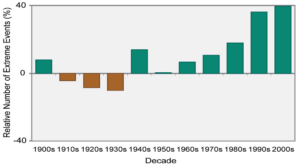Farmers today are experiencing more 4 in. rainfall events during the growing season than ever before. In fact, there has been a 50% increase in heavy rainfall events in the last half century. Throughout the last few days, many areas of the U.S. have experienced large rainfall events (up to 3 to 4 in.) and we’re only in the first half of May.

What’s the big deal about rain?
Jamie Brand, my fellow Regional Agronomy Manager, recently took his 360 SOILSCAN portable soil nitrate testing system into the field to track his fall applied ammonia. The unstabilized anhydrous showed 85 lb.of nitrate at the point of injection while the stabilized anhydrous showed 37 lb. What has happened to that 85 lb. of nitrate?
Depending on soil type, structure, sub-horizons, soil moisture capacity and other factors, 1 in. of moisture can move 6 to 12 in. into the soil profile, or more. That movement could be even more dramatic with the recent 3 in. rainfall events happening in some areas this past week. What’s more, anhydrous is placed at least 6 in. deep. The converted nitrate, already half a foot under ground, with a 3 to 4 in. rainfall begins to move farther and farther into the soil profile.
Heavy rains early in the season move nitrates lower and lower. And, roots systems at this point in the season are shallow and undeveloped. So, it can be assumed that much of your fall-applied N is out of reach of the early-season roots and will likely continue to move with additional moisture.
Make sure your corn has the N it needs
- 360 SOILSCAN can test how much N is in your field in real-time. To find out how much and where your N is, take a 12 in. core and split it at the 6 in. depth and test it with 360 SOILSCAN. That way you’ll know how much N is in your field and throughout the profile.
- Continually monitor rainfall, especially heavy rainfall events. If they continue, be on alert and address N deficiency issues before they have a negative impact on your corn. You don’t want corn to have a bad day.
- Especially, don’t wait until a nitrogen deficiency is visible in the corn plant. By then you have likely lost yield potential. If you realize you have low nitrogen levels early enough, you can supplement your field with an in-season application of N to help rectify the issue. 360 Y-DROP®provides a wide window of application for flexibility of in-season N application.
- Don’t treat your entire field the same because not every acre is the same. Rainfall impacts different yield management zones differently. For example, 3.5 in. of rain on a hill if different than 3.5 in. of rain in a valley. Nitrogen levels will likely vary across your field, especially after large rainfall events. 360 SOILSCAN allows you to test N levels throughout your fields to make smart N application decisions with variable rate prescriptions.
Learn more about adjusting nitrogen management plans based on the weather at our nitrogen management website – www.360yieldcenter.com/nitrogen.